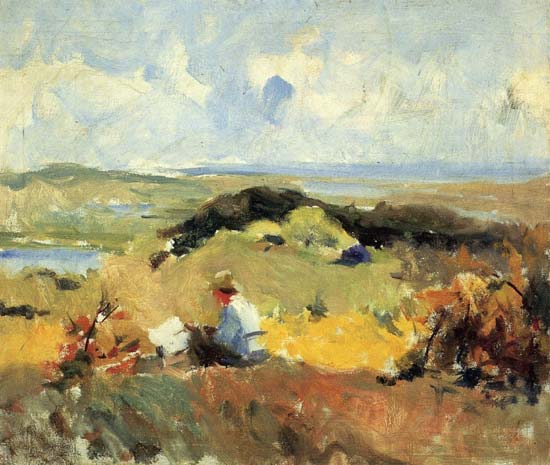
Charles Hawthorne “Artist in Plein Air” 1910
I’ve been thinking about Charles Hawthorne recently – how important it is to keep his words in the front of my mind. His book “On Painting” I return to again and again over the years and still find it as fresh and important as when I first started learning to paint.
“Painting,” he said, “is just getting one spot of color in relation to another spot…. Let color make form, do not make form and Color it.”
“Anything under the sun is beautiful if you have the vision — it is the seeing of the thing that makes it so.”
“The ring, the call, the surprise, the shock that you have out-of-doors – be always looking for the unexpected in nature, do not settle to a formula.”
and
“Get into the habit of doing what you see, not what you know. Human reason cannot foresee the accidents of out-of-doors.”
some good quotes mainly from his book “on Painting” at the Robert Genn’s Painter’s Keys site.
Here is a link to an article about Hawthorne by Stephen Gilman about his teaching at the Cape Cod School of Art.
Another interesting resource on Hawthorne is this link to Google Books on a critical history of Edwin Dickinson that has a section on Hawthorne. I’m not sure how well this link will hold up so you may need to “re-google” at some point – try Edwin Dickinson: A Critical History By John Lawrence Ward, Edwin Walter Dickinson
I also recently found a large treasure trove of images of his paintings and watercolors but I seemed to have lost the link. I’ll post it later once I find it.





Thank you for this. As a Paris-based painter I am always up for new ideas and more painting philosophy. I have ordered “On Painting” by Hawthorne and await its arrival with bated breath! I remember the american artist Charles Reid recommended this book… wish I had bought it years ago…
Jill Roland-Gosselin, Paris
Thanks for commenting.I hope you will find the book as useful and inspiring as I did.
Larry, I have been reading Hawthorne’s “On Painting,” and I wonder if you have come across that treasure trove of images of his paintings. I know it’s been a few years since this post, but I would be most interested. Even if there is a collection somewhere that I could visit, I would consider making the trek. Thanks –
Stacy, let me get back to you on that. It was an online site that I was referring to but perhaps I can find something more where you might see them in person.
Charles Hawthorn’s work and his advice to students has served me well as a painter, since my youth when a friend told me about him. The little book I have is so worn from use it has seen better days. The lineage of Hawthorn to Dickenson and then to George Nick is a wonderful unbroken line of those who know how to share their knowledge and experiences as painters to the next generation. It comes down to some simply stated but essential truths; don’t think but look, paint the color / tone and leave it be, more starts and fewer finishes, among other aphorisms. It is sad that it is so difficult to see the works of Hawthorn and so little is reproduced too. Maybe someone will find the project a worthy one and publish a monograph. I would love to have a copy.
What a great plein-air study with that red accent note on the face!
Thanks for the info on this important painting tutor.
“Paint what you see, not what you know. “(Charles Hawthorne) Makes him very much a precursor of Betty Edwards by about a hunred years or so. I don’t think the french impressionists systemised & taught plein-arisme in quiet the same way nor with such clarity.
The Cape School of Art,was started by Hawthorn here in Provincetown,Ma in 1899 and is still alive and well. Most of the instructors were students of Hawthorne’s assistant Henry Hensche. We still teach the principles of light and color developed by Hawthorne over 100 years ago. We are a non profit school and we focus on color. Please see our mission statement at our website , http://www.capeschoolofart.com. Thanks!
There are numerous descendants of Charles Hawthorne, but the two most prominent direct descendants would be his students, Edwin Dickinson and Henry Hensche. I studied with two students of Dickinson who were steeped in the the approach of Hawthorne. These were Francis Cunningham and Lennart Anderson. While Lennart Anderson is perhaps better known, Francis Cunningham is still something of a “well kept secret.” He took Hawthorne’s “color spot” way of working and refined it as Dickinson did before him. Another way of putting it: it passed through a filter of his unique and varied experience. I have done likewise in putting it to use in my own way. But the fundamental thing about Hawthorne is that he is a pioneer in the way he both demonstrated in paint and articulated in words how pieces of color that are directly observed and abstracted from nature and placed in relation, one to the other on the canvas or panel [etc.], reveal form, space and the quality of light particular to the given motif.
Hi, I discovered the book “On painting” last Fall and now I carry it everywhere. It is incredibly inspiring, clear and vital – and funny, on several passages I had to laugh out loud ..”An illustrator right? i thought so…” and I would love to find a painting teacher like him. The mold might have been broken though, or very rare to find.